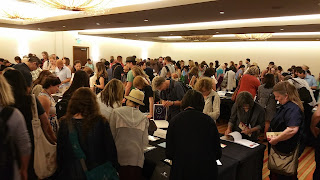One of the many things has been to finish illustrations for my new dummy about an unfortunate owl who can't keep her pets. I remembered to take some video of the process to share with you and wanted to chat during it to explain some of the process that I go through when making an illustration like this.
The nuts and bolts:
Paper: Legion paper, Stonehenge Aqua Coldpress 140lbs/300grm
Watercolors: Windsor & Newton, Daniel Smith, Yarka
Pencils: 2B mechanical pencil, and Derwent Studio color pencils
Brushes: sz 4 for most of it, sz 6 for bigger areas and sz 2 for a few details. No great quality brand name, just what I've gotten from Michaels.
Masking fluid: Schminke white masking fluid in 20ml bottle
Scanner: Epson Perfection V500 Photo Scanner
Printer: Canon Pixma Pro-100
The way I usually work illustrations is that I start with sketching in Procreate, on the iPad. When I finish a good draft, I paint in with approximate colors to resolve any conflicts that might arise later when painting the piece with watercolors.
After I have those two things resolved, I make a simplified line sketch in procreate, that I print out on watercolor paper at about 20% opacity. It's something I learned from Jake Parker's videos, and brilliant, because it takes the stress off from me from making mistakes in the painting. If I mess up with watercolors, I can print another drawing and paint again.
After the paper has been printed, I soak it in water and lay on my Gator board to stretch. If you look carefully, you can see the warping happening in the middle. After about 5 minutes, I flatten it out, and staple (just normal office stapler) it down around all the edges and leave it to dry until the next day.
I like to paint my whole illustration in one sitting if at all possible. I get a feel for the colors I am using and how they apply, and when I have to stop in the middle and continue on a different day, it disrupts the flow. I choose a day both kids are gone, and have several hours of uninterrupted time.
When you watch the video, you can see how I apply the paint, usually in layers, going darker each time, and bouncing around the paper, painting all the same colors in together. Below is an image of my painting set up. Nothing fancy, just basic stuff. On the top, half cut off, is my color sketch printed out, and a jar of brushes.
Here is the time lapse video with chat of the painting process, with some comments on scanning and editing in Photoshop.
Finished illustration with staples being picked out.
And final illustration with edits in Photoshop. Most notably, the red line. I did not want to do it by hand, in any case that I draw it wrong and it has to be redone.
Hope you enjoyed this little insight into my process. I should have another video to show soon and will be working on some new prints in the next few weeks. If you have any questions or comments about this post, just email me or comment below.










